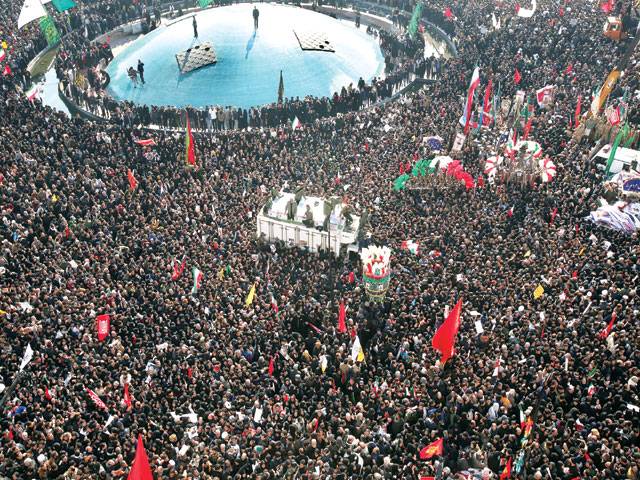Tehran - At least 56 people have been killed in a stampede that erupted in the Iranian city of Kerman at the funeral procession for a top commander killed in an air strike by the United States.
Iranian state TV said at least 56 people have been killed and more than 200 injured in the stampede, citing security sources.
The stampede took place in Kerman, the hometown of Revolutionary Guard Gen. Qassem Soleimani, as the procession began, said Pirhossein Koulivand, head of Iran’s emergency medical services.
There was no information what set off the crush. Online videos showed people lying apparently lifeless, their faces covered by clothing. Emergency crews performed CPR on others as people wailed in the background, crying out to God.
“Unfortunately as a result of the stampede, some of our compatriots have been injured and some have been killed during the funeral processions,” Koulivand said. State TV reported the death toll of 56, with 213 injured, citing Koulivand.
Soleimani’s burial was delayed, with no new time given, because of concerns about the massive crowd that had gathered, the semi-official ISNA news agency said.
A procession in Tehran on Monday drew over 1 million people in the Iranian capital, crowding both main thoroughfares and side streets in Tehran. Such mass crowds can prove dangerous. A smaller stampede at the 1989 funeral for Ayatollah Ruhollah Khomeini killed at least eight people and injured hundreds.
Soleimani’s death in a drone strike Friday has sparked calls across Iran for revenge against America, drastically raising tensions across the Middle East. The US government warned ships of an unspecified threat from Iran across the region’s waterways, crucial routes for global energy supplies. Meanwhile, the US Air Force launched a drill with 52 fighter jets in Utah, just days after President Donald Trump threatened to hit 52 sites in Iran.
Earlier in the day, Hossein Salami, the new leader of Iran’s Revolutionary Guard, vowed to avenge Soleimani’s death as he addressed a crowd of supporters gathered at the coffin in a central square in Kernan.
“We tell our enemies that we will retaliate but if they take another action we will set ablaze the places that they like and are passionate about,” Salami said.
“Death to Israel!” the crowd shouted in response. Israel is a longtime regional foe of Iran.
The funeral processions in major cities over three days have been an unprecedented honour for Soleimani, viewed by Iranians as a national hero for his work leading the Guard’s expeditionary Quds Force.
The US is continuing to reinforce its own positions in the region, including repositioning some forces.
Soleimani’s death already has pushed Tehran to abandon the remaining limits of its 2015 nuclear deal with world powers as his successor and others vow to take revenge. In Iraq, pro-Iranian factions in parliament have pushed to oust American troops from Iraqi soil following Soleimani’s killing at the Baghdad airport.
In his eulogy to the crowd, Salami praised Soleimani’s work, describing him as essential to backing Palestinian groups, Yemen’s Houthi rebels and militias in Iraq and Syria. As a martyr, Soleimani represented an even greater threat to Iran’s enemies, Salami said.
According to a report on Tuesday by the semi-official Tasnim news agency, Iran has worked up 13 sets of plans to avenge Soleimani’s death. The report quoted Ali Shamkhani, the secretary of Iran’s Supreme National Security Council, as saying that even the weakest among them would be a “historic nightmare” for the US. He declined to elaborate.
“If the US troops do not leave our region voluntarily and upright, we will do something to carry their bodies horizontally out,” Shamkhani said.
The US Maritime Administration warned ships across the Mideast, citing the rising threats. “The Iranian response to this action, if any, is unknown, but there remains the possibility of Iranian action against US maritime interests in the region,” it said.
Oil tankers were targeted in mine attacks last year that the US blamed on Iran. Tehran denied responsibility, although it did seize oil tankers around the crucial Strait of Hormuz, the narrow mouth of the Persian Gulf through which 20% of the world’s crude oil travels.
The US Navy’s Bahrain-based 5th Fleet said it would work with shippers in the region to minimize any possible threat.
Meanwhile, Iranian Gen Alireza Tabgsiri, the chief of the Guard’s navy, issued his own warning. “Our message to the enemies is to leave the region,” Tabgsiri said, according to ISNA. The Guard routinely has tense encounters with the US Navy in the Persian Gulf.
Iran’s parliament, meanwhile, has passed an urgent bill declaring the US military’s command at the Pentagon and those acting on its behalf in Soleimani’s killing as “terrorists,” subject to Iranian sanctions. The measure appears to be an attempt to mirror a decision by Trump in April to declare the Revolutionary Guard a “terrorist organization.”
The vote also saw lawmakers approve funding for the Quds Force with an additional 200 million euros, or about $224 million.
Also Tuesday, Iranian Foreign Minister Mohammad Javad Zarif said the US had declined to issue him a visa to travel to New York for upcoming meetings at the United Nations. As the host of the UN headquarters, the US is supposed to allow foreign officials to attend such meetings.
“This is because they fear someone will go there and tell the truth to the American people,” Zarif said. “But they are mistaken. The world is not limited to New York. You can speak with American people from Tehran too and we will do that.”






